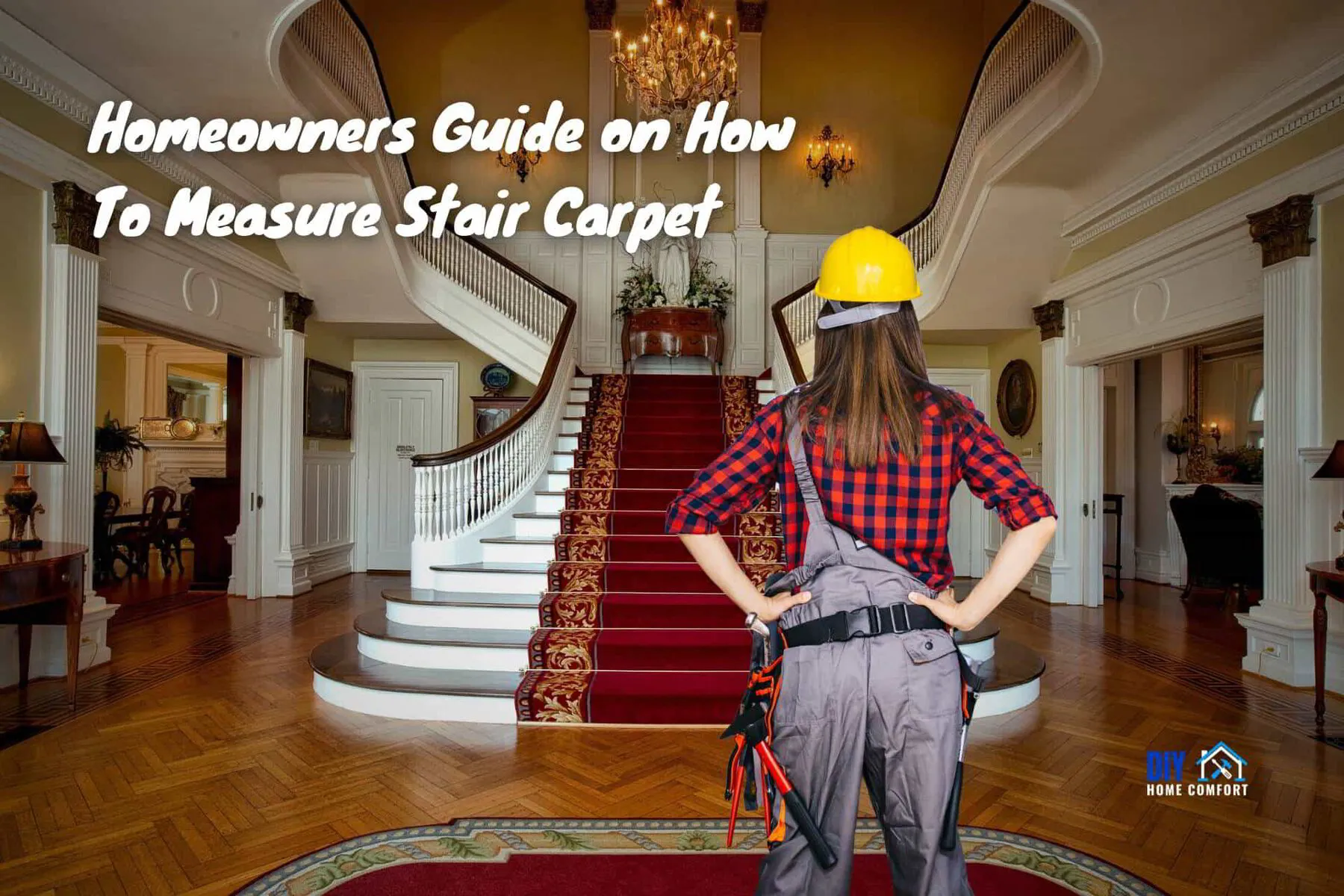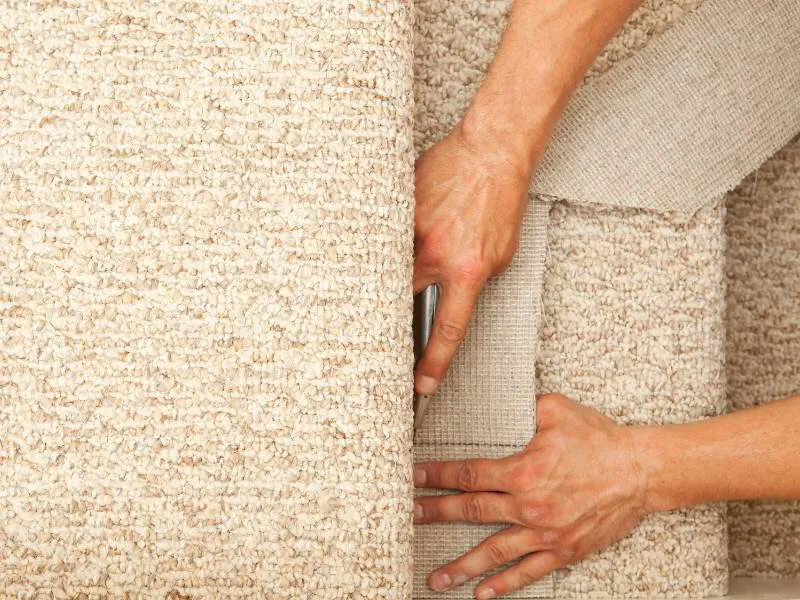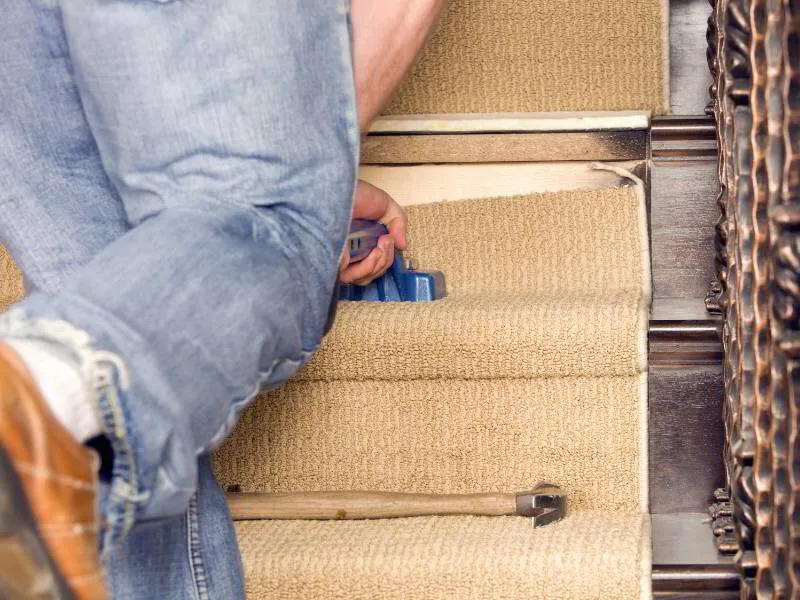Are you considering installing new carpeting on your stairs?
Perhaps you're planning a renovation or just looking to update your home's aesthetics.
Whatever your reason, measuring stair carpeting correctly is crucial for a proper installation.
In this guide, we'll explain why accuracy is essential, cover the tools and materials you need, and provide step-by-step instructions on measuring for different installation types.
You'll also find tips on choosing the right carpet and whether to hire a professional or do it yourself.
Finally, we'll touch on the importance of maintaining your new carpeting to ensure its longevity and appearance.
📘 Key Takeaways
- Accurate measurement of stair carpeting is vital for proper installation, preventing issues like bunching or tripping hazards.
- Essential tools for precise measurements include a tape measure, carpenter's square, level, and flashlight.
- To calculate the carpet amount, measure each step's dimensions and convert it to either square feet or square meters, ensuring consistency in units.
- Consideration of different stair carpet installation types and carpet materials is crucial for achieving the desired look and feel.
- Whether opting for a DIY or professional installation, regular maintenance and prompt stain treatment will prolong the carpet's lifespan and appearance.
Understanding the Importance of Accurate Measurements
Measuring your stair carpet accurately is essential for a proper installation.
An improper fit can result in bunching, creasing, or even dangerous tripping hazards.
Accurate measurements can help you avoid these problems and ensure your new carpeting is an excellent addition to your home's aesthetics and functionality.
Ensuring a Proper Fit
The first and most important reason why accurate measurements for stair carpeting are essential is to ensure a proper fit.
No one wants a bunched-up or creased carpet on their stairs.
Not only does it look unattractive, but it can also be a tripping hazard. Measuring your stairs correctly can help you avoid these problems.
When measuring your stairs, it's important to remember that each step may be slightly different in size.
Therefore, it's crucial to measure each step individually and record the measurements accurately.
This will help you ensure that the carpet fits snugly on each step, without any bunching or creasing.
Saving Time and Money
Accurately measuring your stairs can also save you time and money.
If you measure inaccurately and your carpet doesn't fit correctly, you may have to purchase additional materials or even an entirely new carpet.
This can be costly in terms of money and time wasted.
By taking the time to measure your stairs accurately, you can avoid these extra expenses and ensure that your carpet installation goes smoothly.
This will save you time and money in the long run, and you'll be able to enjoy your new carpeting without any worries.
Avoiding Common Mistakes
Another benefit of measuring your stairs accurately is that it helps to avoid common mistakes homeowners make when installing carpeting.
One of the most common mistakes is measuring incorrectly, which can lead to a host of issues, from an improper fit to wasted materials.
When measuring your stairs, it's important to use the right tools and techniques.
This includes using a tape measure and measuring each step individually.
It's also important to measure the width and length of each step, as well as the height of the stair riser.
By doing so, you can avoid common mistakes and ensure that your carpet installation is a success.
Overall, accurate measurements are essential for a successful stair carpet installation.
By taking the time to measure your stairs correctly, you can avoid common mistakes, save time and money, and ensure a proper fit that looks great and is safe for your family and guests.
Tools and Materials Needed for Measuring Stair Carpet
Measuring stair carpet can be a daunting task, but having the right tools and materials can make the job much easier.
Here are some tools that can help you measure stair carpet with precision:
Tape Measure
A tape measure proves to be an indispensable tool when measuring carpet, as it provides accurate dimensions.
This ensures a perfect fit and eliminates potential waste or mismatched sections, ultimately contributing to a polished and professional-looking result.
Carpenter's Square
A carpenter's square is a useful tool for measuring the corners of each step.
It can help you determine the angle of the step and ensure that your measurements are accurate.
Level
A level can be used to ensure that each step is even and that your measurements are consistent.
This tool can also help you identify any areas where the stairs may be uneven or sloping.
Flashlight
A flashlight can be helpful when measuring stairs that are poorly lit.
It can help you see the edges of each step and ensure that your measurements are precise.
By using these tools to calculate carpet amount and materials, you can ensure that your measurements are accurate and that your stair carpeting fits perfectly.
Remember to take your time and double-check your measurements to avoid any mistakes.
Step-by-Step Guide to Measuring Stair Carpet
Adding carpet to your staircase can make it feel more comfortable and add a touch of elegance to your home.
However, before you can start installing your new carpet, it's important to measure your staircase correctly.
Follow these steps to ensure that you order the right amount of carpet for your project.
PRO TIP: Pick one measurement for all of your calculations. Its either inches and square feet or its millimeters and square meters.
When embarking on your carpet shopping journey, you'll encounter prices listed per square foot.
To ensure you purchase the correct amount, it's essential to calculate the total square footage required for your staircase coverage.
Step 1: Measure the Width of the Staircase
Before you can start measuring each step, you need to measure the width of your staircase.
Measure at the widest point of each stair, typically the bottom stair or stair landing.
Write down the measurement and double-check to ensure that it is accurate.
Step 2: Measure the Height and Depth of Each Step for Length
Once you have measured the width of your staircase, it's time to measure the height and depth of each step.
Use your measuring tape to measure from the back of each step (where it meets the riser) to the front edge of each tread.
Now measure the height of the riser. Include an extra inch to account for the carpet that bends around the nose.
Write each measurement down and double-check to ensure that they are accurate.
It's important to check each step individually, as some steps may be deeper or shallower than others.
✅ PRO TIP: If all your stairs are the same, you can get away with measuring one step and use step 3 to calcuate the square footage
Step 3: Count the Number of Steps
Now that you have measured the width and length of each step, it's time to count the number of steps.
Count each step individually, including the stair landing, if applicable.
Write down the total number of steps and double-check to ensure that you have counted correctly.
Step 4: Calculate the Total Amount of Carpet Needed
With all of your measurements in hand, it's time to calculate the total length or square feet of carpet needed.
To do this, multiply the width of the staircase by the total length in inches.
Divide that number by 12 to get a measurement in square feet. Round up to the nearest whole number.
Then, multiply the square feet of each step by the total number of steps.
Step 5: Factor in Extra Material for Cutting and Fitting
When ordering your carpet, it's important to factor in an additional 10% of the material for cutting and fitting.
This additional material ensures that you have enough carpet to fit around curves and edges and for making any necessary cuts or adjustments during installation.
Without this extra material, you may find that you run out of carpet before the project is complete, which can be frustrating and cause delays.
By following these steps, you can ensure that you order the right amount of carpet for your staircase and avoid any unnecessary delays or frustration during the installation process.
With your new carpet installed, your staircase will look and feel more comfortable, adding a touch of elegance to your home.
Measuring for Different Types of Stair Carpet Installations
Choosing the right carpet for your stairs can make a big difference in the overall look and feel of your home.
However, measuring for stair carpet installation can be a bit tricky, especially if you're not familiar with the process.
Here are some additional tips to help you get the most accurate measurements for different types of stair carpet installations.
Full Staircase Coverage
If you're measuring for full staircase coverage, follow the steps listed above to get a total length of exactly how much carpet is needed.
Be sure to factor in additional material for cutting and fitting as previously mentioned. It's also important to consider the type of carpet you'll be using.
For high-traffic areas, a low-pile carpet may be a better option, while a plush carpet can add a touch of luxury to your staircase.
Additionally, consider the color and pattern of the carpet to ensure it complements the overall aesthetic of your home.
Stair Runner Style
If you're measuring for a runner-style installation, you'll need to calculate the stair width and length of the carpet runner versus full stair coverage.
Measure the width of the staircase and subtract six inches to determine the width of the stair runner.
For the length, measure from the top of the first step to the bottom of the last step and add an additional 12 inches for the top risers and bottom landings.
Use the total length of the stair runner to calculate the amount of carpeting needed, factoring in the extra material needed for cutting and fitting.
Keep in mind that stair runners can be a great way to add a pop of color or pattern to your stairs, but they may not be the best option for homes with small children or pets, as they can be a tripping hazard.
Individual Stair Treads
Individual stair treads require individual measurements for each stair tread.
Measure the stair tread as per the steps above.
Add an additional 10% for cutting and fitting, as previously mentioned, to determine the total length of carpet needed.
When selecting carpet for individual stair treads, consider a durable and stain-resistant option, as these treads tend to experience the most wear and tear.
Additionally, consider adding a non-slip backing to prevent slips and falls.
By following these tips, you can ensure that your stair carpet installation is a success, adding both style and function to the floor of your home.
Tips for Choosing the Right Carpet for Your Stairs
If you're looking to add warmth and comfort to your home, carpeting your stairs can be a great option.
However, with so many different materials, colors, and styles to choose from, it can be overwhelming to make a decision.
Here are some tips to help you choose the perfect carpet for your stairs.
Consider Durability and Foot Traffic
One of the most important factors to consider when choosing stair carpeting is durability.
Stairs tend to experience higher traffic volumes than other areas of the home, so it's important to choose a carpet that can handle the wear and tear.
Look for stair carpets that are specifically designed for high-traffic areas, such as loop pile or cut pile carpets.
In addition to durability, you'll also want to consider the level of foot traffic your stairs receive.
If you have kids or pets, for example, you'll want to choose a carpet that can withstand spills, stains, and heavy use.
Selecting the Right Material
When it comes to carpet materials, there are several options to choose from. Nylon, wool, and polyester are all popular choices for stair carpeting.
Nylon is a durable and affordable option that is resistant to stains and wear.
Wool is a more expensive option, but it is also more luxurious and durable.
Polyester is a budget-friendly option that is soft and comfortable underfoot.
Consider your needs for durability, cleaning ease, and aesthetics when choosing a material.
Matching Your Home's Aesthetic
When choosing a carpet for your stairs, it's important to consider the overall aesthetic of your home.
Look at the color of your walls, furniture, and decor to choose a carpet that complements your home's style.
If you have a modern home with clean lines and minimalistic decor, a neutral-colored carpet with a subtle pattern can add warmth and texture without overwhelming the space.
If you have a traditional home with ornate details and rich colors, a plush carpet in a deep, rich hue can add a touch of elegance and sophistication.
By considering durability, material, and aesthetics, you can choose the perfect carpet for your stairs that will add comfort and style to your home for years to come.
Pros and Cons of Hiring a Professional
Hiring a professional to install your stair carpet can be a great option if you're unsure of your measuring and installation abilities.
A professional can ensure that the carpeting fits correctly, provides safety, and maintains your stairs' integrity.
They also have the experience and tools needed to get the job done efficiently and effectively.
However, there are some potential drawbacks to hiring a professional.
First and foremost, it can be expensive.
You'll need to pay for the installer's time and expertise, as well as any materials they use.
Additionally, if you choose the wrong installer, you may end up with subpar work and additional costs to fix any mistakes.
If you do decide to hire a professional, be sure to choose an experienced and reputable installer.
Do your research and read reviews from past customers to ensure that you're getting a quality job for your money.
Pros and Cons of DIY Installation
If you're handy and have experience with measuring and installing carpeting, a DIY project may be the right option for you.
DIY installations can be cost-efficient and rewarding as you can take pride in the work you've done yourself.
You also have complete control over the process and can ensure that everything is done to your exact specifications.
However, there are some potential downsides to a DIY installation.
If you don't have the proper tools or experience, you may end up making mistakes that could be costly to fix.
Additionally, if you don't follow the manufacturer's instructions carefully, you may end up with a subpar installation that doesn't look or function as well as it should.
If you do decide to go the DIY route, be sure to read the manufacturer's instructions carefully, utilize proper tools, and take your time with installation.
Measure twice, cut once, and don't be afraid to ask for help if you need it.
Making the Right Choice for Your Home
Ultimately, the decision to hire a professional or do it yourself should be based on your experience, comfort level, and budget.
If you're confident in your abilities and have the necessary tools and experience, a DIY installation can be a great way to save money and get the job done to your exact specifications.
However, if you're unsure or don't have experience with this type of project, it may be worth it to hire a professional to ensure a quality installation that will last for years to come.
Regardless of which option you choose, take the time to measure properly for a successful installation.
Whether you're installing carpeting on your stairs or tackling another home improvement project, proper planning and preparation are key to a job well done.
Maintaining Your Stair Carpet
Choosing the right carpet for your stairs can make a big difference in the overall look and feel of your home.
However, measuring for stair carpet installation can be a bit tricky, especially if you're not familiar with the process.
Here are some additional tips to help you get the most accurate measurements for different types of stair carpet installations.
Regular Cleaning and Vacuuming
Regular cleaning and vacuuming are essential to maintaining your stair carpet's appearance.
Vacuum your stairs at least once a week, using an attachment to reach the edges and corners of each step.
Consider a deep cleaning every six to twelve months to remove deep-set dirt and grime from the carpet fibers.
Addressing Stains and Spills
Stains and spills are a fact of life, but quick action can prevent permanent damage to your stair carpeting.
Clean up any stains or spills immediately, using the manufacturer's recommended cleaning solution if available.
Avoid using hot water or harsh chemicals as they can damage the carpet.
Periodic Professional Cleaning
Consider periodic professional cleaning to maintain the appearance and longevity of your stair carpet.
Professional cleaners have the tools and expertise needed to thoroughly clean and remove dirt and stains from your carpet while protecting the fibers.
Final Thoughts on How to Carpet Stairs
Measuring stair carpeting may seem like a daunting task, but with the right tools, materials, and knowledge, it can be completed successfully.
Accurate measurements are crucial to ensure a proper fit, save time and money, and avoid common mistakes.
Consider the different installation types and the material of the carpet and choose a professional or DIY installation based on your experience level.
Finally, maintain your stair carpeting with regular cleaning, addressing stains and spills immediately, and consider professional cleaning periodically.
By following these tips, you can enjoy your new carpeting for years to come.
Thanks for reading!
📘 Related Reading: The Ultimate Guide to 16 Different Types of Staircases
Lara Harding
Lara is a supporting author @ DIY Home Comfort. She's an experienced interior designer and decorator and a full-time mom. You can find out more about her here.









